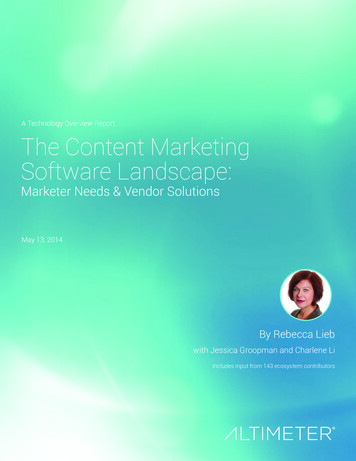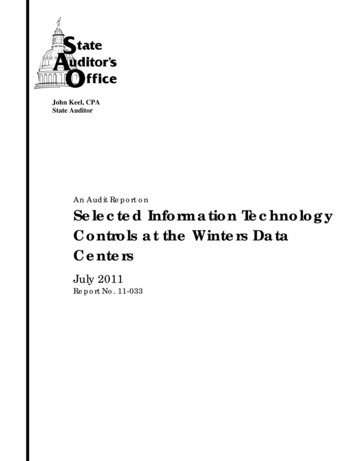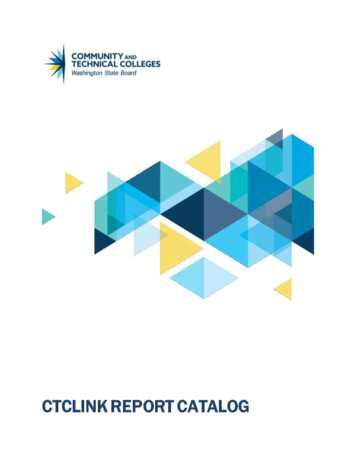
Transcription
A Technology Overview ReportThe Content MarketingSoftware Landscape:Marketer Needs & Vendor SolutionsMay 13, 2014By Rebecca Liebwith Jessica Groopman and Charlene LiIncludes input from 143 ecosystem contributors
Executive SummaryThe content marketing tool landscape is crowded, rapidly changing, andhighly inconsistent. Evolution and change are rapid. Marketers struggle toselect the right tools not only for their own content marketing needs, butalso solutions that integrate with enterprise, process, and platform concerns.This report helps marketers make informed buying choices by mapping eightneeds scenarios to the existing vendor landscape.Table of ContentsWhy Content Marketing Tool Selection Is So Hard . . . . . . . . . . . . . . . . . . . . . . . . . . . . . . . . . . . . . . . . . . . . . . . . . . . 3A Tangled and Emerging Vendor Landscape Complicates the Picture . . . . . . . . . . . . . . . . . . . . . . . . . . . . . . . 4Content Stacks Will Emerge . . . . . . . . . . . . . . . . . . . . . . . . . . . . . . . . . . . . . . . . . . . . . . . . . . . . . . . . . . . . . . . . . . . . . . . . . 6Technology Decisions Must Begin With Use Cases . . . . . . . . . . . . . . . . . . . . . . . . . . . . . . . . . . . . . . . . . . . . . . . . . . 8Content Tool Best Practices . . . . . . . . . . . . . . . . . . . . . . . . . . . . . . . . . . . . . . . . . . . . . . . . . . . . . . . . . . . . . . . . . . . . . . . . . 11The Present and Future Vendor Landscape . . . . . . . . . . . . . . . . . . . . . . . . . . . . . . . . . . . . . . . . . . . . . . . . . . . . . . . . . 13Endnotes . . . . . . . . . . . . . . . . . . . . . . . . . . . . . . . . . . . . . . . . . . . . . . . . . . . . . . . . . . . . . . . . . . . . . . . . . . . . . . . . . . . . . . . . . . . . 16Methodology . . . . . . . . . . . . . . . . . . . . . . . . . . . . . . . . . . . . . . . . . . . . . . . . . . . . . . . . . . . . . . . . . . . . . . . . . . . . . . . . . . . . . . . . 16Ecosystem Input. . . . . . . . . . . . . . . . . . . . . . . . . . . . . . . . . . . . . . . . . . . . . . . . . . . . . . . . . . . . . . . . . . . . . . . . . . . . . . . . . . . . . 16Acknowledgements. . . . . . . . . . . . . . . . . . . . . . . . . . . . . . . . . . . . . . . . . . . . . . . . . . . . . . . . . . . . . . . . . . . . . . . . . . . . . . . . . . 16About Us. . . . . . . . . . . . . . . . . . . . . . . . . . . . . . . . . . . . . . . . . . . . . . . . . . . . . . . . . . . . . . . . . . . . . . . . . . . . . . . . . . . . . . . . . . . . . 18
The Content Marketing Software Landscape:Marketer Needs & Vendor SolutionsWhy Content Marketing Tool Selection Is So HardIt used to be so simple. Content marketing consisted merely of writing content and putting iton a website. It’s now evolved into a complex process involving multiple players throughoutthe organization, outside agencies and vendors, multimedia, and a proliferation of channels.Growing channel and media complexity, as well as increasing adoption of content marketing,has given rise to a large, complex, and highly disparate content marketing software landscape.Understanding what tools are available and, more importantly, what tools areneeded for content marketing efforts echoes the proverb of the blind mendescribing an elephant. There are point systems, enterprise solutions, andhybrids, yielding very few apples-to-apples comparisons in the marketplace.Complicating an already complicated set of choices is the fact that marketersstill have a scattershot approach to content. Altimeter finds 70% of marketerslack a consistent or integrated content strategy. Despite a growing awareness(and acceptance) of the fact that content is the atomic particle of all marketing— essential for fueling paid, owned, and earned media — organizations lack acohesive, coherent, strategic approach to content.Other trends driving the complexity of the content marketing tools decisioninclude the following: Content creation pressure: Creating and publishing content is hard,unrelenting work. As a result, marketers tend to focus on the tactics ofcreation and just “getting content done.” Exacerbating this is a campaignfocus — if content strategy exists at all, it typically revolves aroundindividual campaigns. Lack of strategy begets tool proliferation: One national retailer dividescontent and channel responsibilities between Marketing, PR, Brand,HR, Community, Social Media, and Web, with no central coordination oroversight. Ad hoc execution without goals, processes, communication,and governance inevitably leads to ad hoc tools and random platformpurchasing. The result is overlapping workflows and a hodgepodge oftools that are fragmented and often redundant.370%Percentage ofmarketers whosay they lacka consistentor integratedcontent strategy
Lack of enterprise integration: When solutions areInterestingly, our research found that vendoracquired haphazardly, they often don’t integrateinvestment in product improvements correlate andor work with other enterprise systems. Only 10%align with marketers’ stated needs rather than theirof marketers we surveyed say their content toolsplanned investments.are integrated into processes such as inboundFigure 1 depicts needs and investments across the eightmarketing platforms, business intelligence, or CRM.primary content marketing use cases we identified inYet when pressed, marketers have long lists ofour research of marketers, experts, and vendors. Weneeded integrations from their content systems.assess marketer needs and vendor solutions through theBeyond technology platform integration, digitallens of these eight use cases in order to facilitate propercontent workflows also exist, mainly on their own,alignment between the two.with little integration into organizational processes. investments: Our research finds 67% of marketersA Tangled and Emerging VendorLandscape Complicates the Pictureidentify audience identification and targeting as aBecause content marketing has so many permutationsMisaligned buyer needs versus plannedtop need — pointing to the trend of content aligningacross hundreds of platforms, the content marketing tool’swith advertising and other marketing initiatives.landscape is a mishmash of vendors, categories, andYet only 25% are actively investing in this area intechnology platforms that make it difficult, if not impossible,2014 (see Figure 1). The need to scale up contentto make apples-to-apples comparisons between solutions.creation is a tactical distraction from deeperWhile some basic technology maps of content marketingstrategic needs.tools exist, they support neither vendors’ go-to-marketFigure 1 Buyers’ Needs Don’t Match Planned Investments67%67%60%53%48%Audience &TargetAnalyticsCreationDistribution22%Curation &AggregationBase: Altimeter Group Content Marketing Survey 2014, n 80 marketersSource: Altimeter ion24%Legal25%21%IntegrationNeedsInvestments
strategy nor marketers’ decision-making processes.1profitable. A third offer is a freemium model withinMaking this even more confusing are three trends:which one-third of their customers pay nothing for theTrend 1. Many solutions exist.service. Of course, a small handful of giants — namely,Adobe, Oracle, and Salesforce.com — loom over theTools to manage, create, measure, optimize, andlandscape, all rapidly acquiring and consolidatingotherwise wrangle content marketing are rapidlyplayers. These giants serve the entire marketingproliferating. Altimeter Group identified over 110spectrum, brand themselves as “marketing clouds,” andcontent marketing vendors, exclusive of certainare beginning to use terms such as “content alignment”categories, including email, marketing automation,and “converged media” in sales collateral and valuecontent management systems (CMS), digital assetpropositions.management solutions (DAMs), and social mediaand multifaceted. Mergers and acquisitions (M&A)Trend 3. Content marketing evolution is drivingconsolidation.activity is rapid. Just tracking the content vendorWe found that the movement of content marketingecosystem is a near full-time job.toward converged media — organizations are developingTrend 2. The content vendor landscape is sharplybifurcated.capabilities to make owned content more fluid so it canmanagement software (SMMS).2 The market is diverseThe majority is small — only 6% of companies wesurveyed have over 100 employees and are not yetbe used, optimized, and deployed in shared (usuallysocial media) and paid (advertising) channels — createspressure for vendors to match this emerging need withfuller offerings.Figure 2 Media Convergence Drives Content Stack alyticsEarnedMediaSource: Altimeter GroupWorkflowCreationCuration&Aggregation
Figure 2 illustrates the relationship between converged media and contentmarketing use cases, which are often transmedia in nature. This convergenceof media development and deployment is contributing to the evolution of thecontent “stack,” away from disparate point solutions serving limited needs.In some cases, point solutions are being strung end-to-end to createincreasingly broader content marketing platforms. For example, Scripted,Percolate, and Contently, which all began as written-word providers, allrecently added graphics capabilities into their toolsets.The giant providers are also jumping in. Recent major moves include Adobe’sannouncement of its intention to integrate its Creative and Marketing Clouds;Oracle’s acquisition of Eloqua, Responsys, and Compendium; and Salesforce.com snapping up ExactTarget, Buddy Media, and Pardot. Most recently, IBMmade a tentative foray into the space by buying Silverpop.Content Stacks Will EmergeWhile fragmented today, Altimeter believes that the content marketing toollandscape will begin to consolidate in earnest. By 2016, there will be “contentstack” offerings in the marketplace — end-to-end solutions akin to ad stacks.Currently, no single vendor has an end-to-end solution. Eventually, a few willpartner, merge, acquire, and/or collaborate to create a total solution.Content solutions will also soon absorb other software categories. Forexample, the distinction between SMMS and content marketing tools isblurring and will soon vanish as marketers and vendors demand contentcapabilities in a growing number of platforms. Close to 85% of contentmarketing tools publish on social platforms, a number not statisticallydifferent than their ability to publish on websites. This will render most socialonly tools redundant. “The big marketing technologies like Social Publishingand Marketing Automation don’t work without content. Content is the fuel;you can’t have one without the other,” explains Doug Pepper, general partnerof Interwest Partners.Figure 3 is Altimeter Group’s Content Tools Stack Hierarchy, which illustrateshow primary content marketing use cases align against the three commonpains content marketers face, as described in the next section.6By 2016,there will be“content stack”offerings in themarketplace— end-to-endsolutions akin toad stacks.
Figure 3 Content Tool Stack HierarchyLegal & ComplianceTools designed for review/approval andcompliance across all necessary stakeholders.WorkflowTools that aid in processes associated with contentstrategy including creating governance documentation(style, editing and brand guidelines), content audits,production, review, approval and publishing processes, etc.DistributionConvergenceTools that help content publishers find audiences via,for example, suggested headlines or stories acrosspublisher sites or social networks.Audience & TargetingTools to help identify who the target audience(s) is/are, where theyare online, and the types of content that would attract them.AnalyticsIndependent of basic web analytics packages, content tools often containtheir own specific analytics and dashboards.These can be wide rangingand are, of course, closely aligned with tool functionality.OptimizationTools designed for ongoing optimization of content marketing results over time.Curation & AggregationTools or processes that aid in the discovery, compiling, organizing, presenting,and publishing of existing content in a meaningful waythat is on-brand and relevant to campaign goals.CreationTools that aid in developing, building, and deploying consistent content.Source: Altimeter Group7
Technology Decisions Must BeginWith Use CasesAltimeter Group approaches the content marketingtools problem from the perspective of marketingthree phases and escalate in complexity.3 Here’s aquick overview of each of the scenarios and relateduse cases.1) Feed the Beastchallenges and needs first, asking what challengesIn this initial phase, the organization struggles to keepface content marketers today and how can technologyup with the unrelenting demands of regularly creatinghelp solve them? As marketer needs evolve over time,quality content for one or more channels. They typicallyso will solutions sets. The key is not more or betterlack a coherent strategy and have only a bare bonespoint solutions but how they come together. Altimeterorganizational structure (often stemming out of socialrecommends taking the following three steps tomedia). They require a steady stream of ideas anddetermine your content marketing tool stack:inspiration, as well as the basic tools of content creation.1) Determine your content marketing use cases.2) Plan for integration and evolution.Ultimately, this phase is characterized by the need tomaster the foundational use cases in content marketing:efficiently creating and collecting content at scale.3) Identify and prioritize vendors based on those use cases.Step 1. Determine Content Marketing Use Cases2) RefineIn this scenario, process is applied to content creationAltimeter Group has identified three content marketingand production. This is the stage at which a team beginsscenarios, laddering up from an immature “feed-the-to take shape and roles beyond content creation form,beast” tactical approach to a mature, process-driven,e.g., analytics. Content is audited and assessed, oftenstrategic stage that closely mirrors our Contentwith a formal scoring or grading process. Channels,Marketing Maturity Model (see Figure 2). Throughoutaudience, and persona considerations play a greatlythese scenarios, we found eight overarching contentexpanded role in creation. Content is optimized for digitalmarketing use cases, each with a complement ofand social distribution, and efforts are made to identifysubcategories. The eight use cases fall into roughlyrepeatable, sustainable content practices. The leaderFigure 4 Three Content Marketing Scenarios Drive Tool SelectionFeed the BeastWhat are we tracking,where, and why?GovernHow can we create (more)content faster?How can we get smarterabout content marketing?How can we operate in real-timeand ensure compliance?Where can we find ideasfor content creation?RefineHow can we scale effortsacross the organization?Source: Altimeter Group8
of the content group makes a more concerted effort toGather Cross-Functional Requirements & Determineconnect content development with the broader marketingUse Casesteams. The Refinement Phase in content marketing isTo help identify use cases, take a look at the moreabout getting smarter, optimizing processes, insights,granular subcategories within each use case (Figure 5)targeting, and program deployment.and assess those needs that apply to your organization.3) GovernAs a best practice, be certain to solicit stakeholders andIn this scenario, there is a need for the content strategyend-users for requirements, input, and collaboration.to be formalized and communicated throughout theForty-one percent say those responsible for contententerprise; for example, governance and processes arehave a voice in selecting the tools and technologies theyfirmly established to meet regulatory requirements.use to execute. Marriott International’s Senior DirectorFocus shifts toward expanding the team and itsof Digital Strategy & Distribution Meg Walsh calls thisability to create experiential, engaging, multimediaa critical part of the assessment: “We did a series ofcontent rather than simpler stories and informationalworkshops with the content creators and manipulatorspieces. Content is created with a view toward beingand talked about what they needed to be able to doreusable and/or repurposed across paid and earned,from a technology perspective. So much came downas well as owned, media channels. Legal and industryto workflow, particularly around transparency and thecompliance rules and regulations are understood, andability to understand what’s happening with content atguardrails are in place to ensure compliance.any given point.”Figure 5 Content Marketing Use CasesCuration &AggregationCreationGenerate digital contentCreate standardizedformatsDisplay aggregated contentExpedite the publishingprocessDiscovering the rightcontentOptimizationAnalyticsOptimize search (SEO)Analyze all content artefacts(central dashboard)Conduct multivariatetestingReal-time reports& notificationOptimize contentconversionAudience& TargetingDistributionIdentify & target specificcustomer segmentsDisseminate content acrossmultiple channelsEngage influencersCorrectly render contentacross channelsIntegrated targeting(via CRM, analytics)Deploy predictiveanalyticsWorkflowSource: Altimeter Group9Feed the BeastSelectively compile contentfrom disparate sourcesRefineDeploy paid mediastrategically acrosschannelsLegal &ComplianceEditorial calendarsEnsure complianceStreamline approval processacross stakeholdersMaintenance of outdatedcontentSource & managetalentLegal approvalsGovern
Step 2. Plan for Integration and EvolutionIntegration considerations are essential because of the pending consolidationdriven by converged media, as well as the evolution of content stacks. Eachof the eight content marketing use cases come with a host of potentialintegration issues, yet only 10% of marketers say their content marketingtechnologies are “fully integrated across people, processes, and platforms.”Identifying essential integrations can help refine a final list of prospectivevendors. Content marketing software integration is tripartite:1.Integration with systems. This includes legacy and often future platforms, such as data andanalytics, CRM, and inbound marketing. Petco’s Chief Content OfficerGreg Seremetis emphasizes his group’s voice is one of many at the tablewhen new tools are discussed and vetted inside the company.2.Integration with the organization, such as internal communications,corporate intelligence and internal networks. “Why shouldn’t our call center agents have access to same informationthat guests have?” asks Walsh at Marriott International.3.Integration with processes, including workflow and organizationalstructure. This may include taking outside partners and/or agencies into account.“You can’t retrofit activities to the tool; you have to align the tool with youractivities,” according to Kristina Halvorson, CEO & founder of Braintraffic. Our research found that there are common integration points marketersleverage across each use case (see Figure 6). While not universalto all marketers’ scenarios, these integrations fall into eight primarycategories. The figure below charts how these common points ofintegration typically map against use cases.10“You can’t retrofitactivities to thetool; you have toalign the tool withyour activities.”Kristina HalvorsenFounder & CEO, Braintraffic
Figure 6 Content Marketing Integration NeedsAdExchangeDisplayInventorySourcesMobileAd ServersDesktopAd ServersData &AnalyticsWeb AnalyticsBusinessIntelligenceCRMMobile DataE-CommercePlatformsA/B TestingToolsCreationCuration &AggregationOptimizationAudience &TargetAnalyticsDistributionWorkflowLegal &ComplianceSource: Altimeter Group11DigitalMediaPublisher/News ormMarketingCloudOther CM ToolsMarketingAutomationSMMSPublishing &Embedding ToolsE-MailMarketing ToolsInfluencer IDToolsSearchEnginesSearch ePlatformsSyndicationToolsCloud StorageRSS FeedsCMSSyndicationWidgetsDAMWeb Server
Step 3. Identify and Prioritize VendorsOnce a solid understanding of use cases and integrationneeds is reached, marketers can employ the followingselection. Rank use cases in order of priority, maintainingfocus on the top three to five most important use cases(see Figure 7).checklist to help prioritize those needs for vendorFigure 7 Content Marketing Needs ChecklistMarketer NeedsPriority Integration(s)o Generate digital contento Create standardized content formatso Expedite the publishing processCreationo Sharing Platformso Data & Analyticso Digital Mediao Marketing Cloudo Storage Platformso Compile content from disparate sourceso Display aggregated contento Discover the right content (for ideas, for sharing)Curation &Aggregationo Sharing Platformso Searcho Digital Mediao Marketing Cloudo Storage Platformso Syndication Platformso Optimize search (SEO)o Conduct multivariate testingo Optimize content conversionOptimizationo Sharing Platformso Ad Exchangeso Searcho Data & Analyticso Marketing Cloudo Storage Platformso Identify & target specific customer segmentso Engage influencerso Integrated targeting (via CRM, email marketing,analytics, etc)Audience &Targetingo Sharing Platformso Ad Exchangeso Data & Analyticso Marketing Cloudo Storage Platformso Analyze all content artifacts (central dashboard)o Real-time reporting & notificationo Deploy predictive analytics to drive contentmarketingAnalyticso Sharing Platformso Data & Analyticso Marketing Cloudo Storage Platformso Disseminate content across multiple channelso Display content correctly across channels (incl.device types)o Deploy paid media strategically across channelsDistributiono Sharing Platformso Ad Exchangeso Searcho Data & Analyticso Digital Mediao Marketing Cloudo Storage Platformso Syndication Platformso Organize content cadenceo Streamline approval process across necessarystakeholderso Talent sourcing & managementWorkflowo Sharing Platformso Marketing Cloudo Storage Platformso Profile content for complianceo Store & disposal of historical contento Legal approvalsLegal &Complianceo Ad Exchangeso Digital Mediao Marketing Cloudo Syndication PlatformsSource: Altimeter Group12Use Case
Having prioritized use cases and integrationrelevant content in a timely fashion,” as Andrewrequirements, the next step is to figure out whichMilburn at American Express puts it. Foremostvendors can satisfy the requirements of those useamong marketers’ planned investment in contentcases. Altimeter requested information from 110 contentmarketing software are tools to aid in the rapidmarketing vendors, and 53 provided responses to ourcreation and deployment of content, particularlyextensive survey. Each vendor was not only asked whichfor those utilizing various forms of real-timeuse cases they supported, but also asked to force rankmarketing.4 Rapid personalization, delivery, and thewhich use cases they supported best.ability to build content based on buzz is a primaryThe results are summarized in the appendix. Take aconsideration.look at your own prioritized use cases developed in Consider IT support (or lack thereof). WhetherStep 1 above, and see which vendors should be on youra solution requires initial or ongoing supportshort list because their priorities match your own. Youfrom IT is a consideration for many marketingmay also consider working with multiple small vendorsorganizations, particularly with an ever-increasingwho provide point solutions, because they concentrate“need for speed.” A growing trend is solutionson key use cases that are important to your contentthat enable marketing to bypass IT for day-to-daymarketing organization.publishing needs on owned media, such as designContent Tool Best Practiceschanges to a website.Regardless of an organization’s specific softwareneeds or level of content marketing sophistication,there are best practices around assessing, buying andintroducing new content marketing software that areuniversally applicable. Train staff to use tools (and on content marketing/strategy in general). Only 24% of the marketers wesurveyed say employees are formally trained andempowered to publish on behalf of the brand. marketers may not be using today — e.g., mobile,real-time marketing, native advertising, futureenterprise technology investments, or localizationfor international markets — can rapidly becomeurgent realities that will require urgent integration.“Can it scale?” is a difficult, yet essential questionwhen considering content marketing softwareinvestments. Internationalization and localizationare often overlooked when global enterprises investin tools. Language, local channels and platforms,in content marketing software functionality, e.g.,and other region/country specific considerationsnearly all tools have some sort of built-in analyticscan be critical criteria. Both LinkedIn’s Jason Millerdashboard. Yet, marketers often invest in a tool forand Petco’s Greg Seremetis adopt an experimentalits primary feature without realizing that there aretest-and-learn approach, trialing new solutions priorsecondary or tertiary features that they then buyto investing in them.don’t align when viewed in aggregate.” This is anThe Present and Future VendorLandscapeimportant consideration for cost efficiencies as well:The content marketing vendor landscape is in a period of40% of the content marketers we surveyed reporthyper-growth and hyper-consolidation. The dust won’tthat the lack of inter-departmental coordination issettle for several years. Some of the overarching trendsleading to disparate tools being used.we’re seeing in the tumult include the following:Build for speed. How quickly and efficiently teamsBigger doesn’t mean better — and vice versa. Zoomforth,can implement, set up, train, and use new toolsa two-year-old startup with three employees, serves“one version of the truth” vs. “multiple realities thatis paramount, as is how quickly tools can “deliver13Scale toward the future. Channels and tactics thatAvoid redundancies.There is considerable overlapelsewhere. Related to this is integration driving
enterprise clients, such as Deloitte, AT&T, and Adidas.The largest content enterprise players (Adobe, Oracle,Salesforce.com) service small and medium-sizebusinesses alike, which they are striving to buy andintegrate their way into the sector, and their intentionsand long-term visions are far from realized.Of the Goliaths, it’s Adobe’s battle to lose given its robustand well-established Creative Cloud. However, that family ofproducts is geared more toward publishing than marketing,and many essential use cases reside in the company’sMarketing Cloud. While Adobe recently announced itsintention to integrate the clouds, that’s easier — and muchmore quickly — said than done. Adobe has also alignedwith start-ups, such as Thismoment, that offer neededcapabilities around legal, compliance, and UGC.The above reasons account for the fact that whenvendors are questioned about their competitors,Adobe’s name trails after more marketing-orientedsolutions. The other Goliaths, Oracle and Salesforce.com are aggressively acquiring capabilities, while IBMis a laggard.Investment and acquisition have not yet peaked. Newvendors continue to emerge; existing ones are addingcapabilities (and enjoying significant new rounds offunding). The marketing clouds are still on an acquisitivetear. These are all signs of growth rather than maturity. Itwill be a couple of years or more before the market shakesout and normalizes and a few content stacks begin toemerge. Content stacks will be similar in structureand function to ad stacks, with which they will integrate.Eventually, this will become the true meaning of the term“marketing cloud.” Again, Adobe holds the most pieces ofthis puzzle, but assembling them won’t be fast, or easy.Vendors are listening to customers and integratingaccording to their needs. Vendors are prioritizinganalytics and attributable cross-channel marketing byemploying a wide range of integrations. And while nota primary use case today, one out of three vendors willbe deploying Audience & Targeting capabilities in thenext 12 months, matching marketers biggest “want” incontent capabilities.14
Appendix: Individual Vendor CapabilitiesThe following table was compiled based on the research Altimeter conducted across content marketing vendors wesurveyed. Vendors were able to self-select which of the top eight use cases they supported and then rank the top three theybest support. This information is self-reported by the surveyed vendors who were asked to rank, in order, the top three usecases they support (1-3), as well as to indicate which other use cases their solution addresses with a solid circle ( l ). If avendor does not report supporting a use case, it is designated with a hollow circle ( o ibutionAudience &TargetingAnalyticsOptimizationLegal ooll1AdobeAhalogyBloomReachBrandle, Inc.BrightInfoContentlyCurataDivvyHQEbylineExpion LLC.Flite Inc.idioInboundWriterinPoweredKapostKentico SoftwareKonteraLinqia, incLivefyreLookBookHQMass RelevanceMovableMe
Content marketing consisted merely of writing content and putting it on a website. It’s now evolved into a complex process involving multiple players throughout the organization, outside agencies and vendors, multimedia, and a proliferation of channels. Growing channel and media complexity, as well as i











